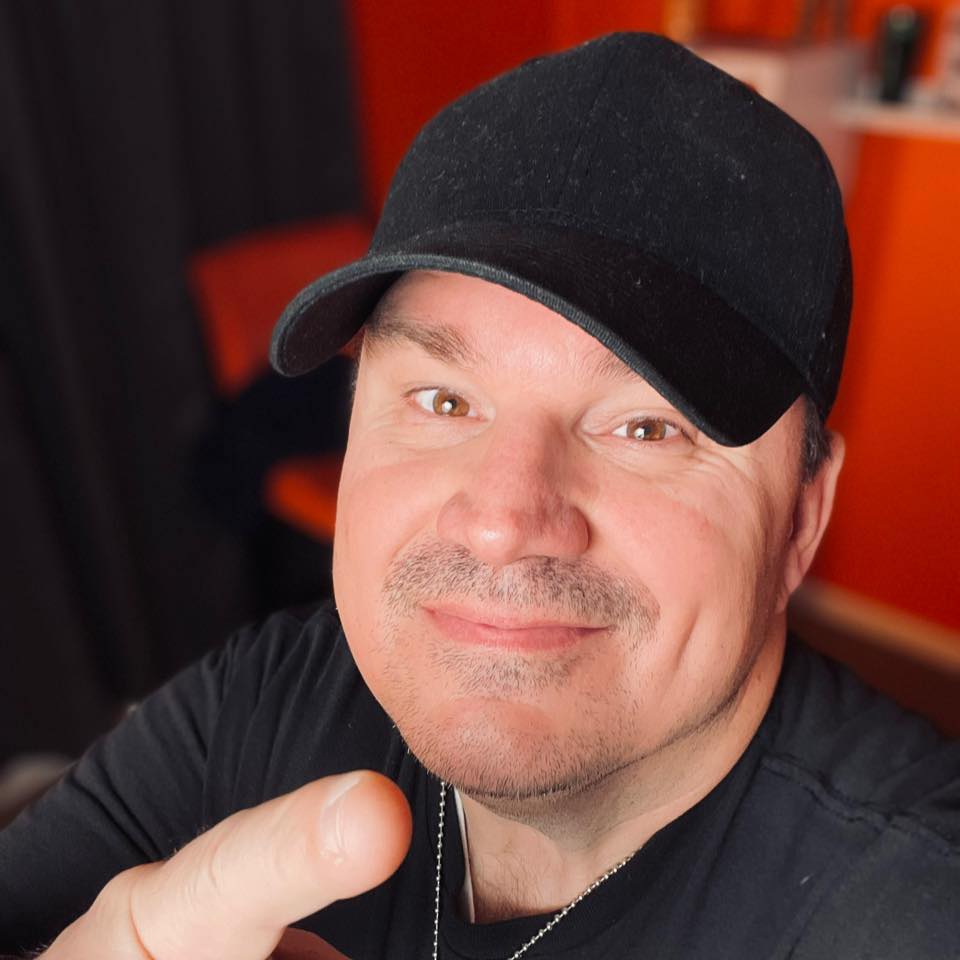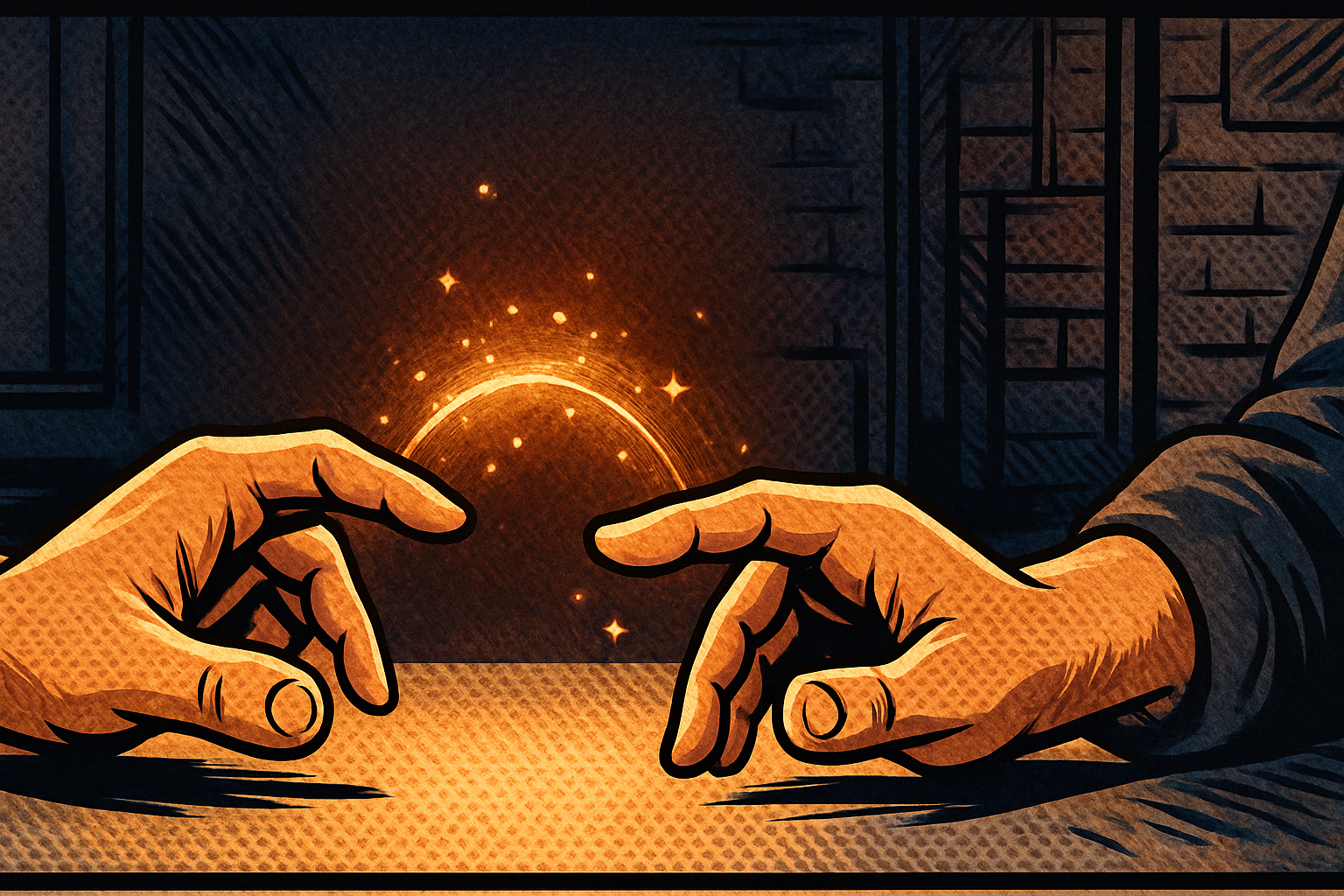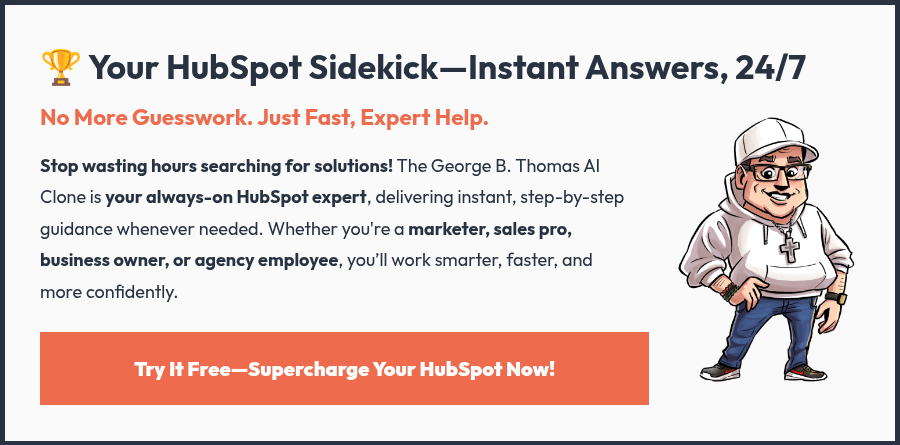9 min read
What Happens When You Name Your AI Tool? Meet CHIP!
 George B. Thomas
Oct 3, 2025 2:51:31 PM
George B. Thomas
Oct 3, 2025 2:51:31 PM
Rather listen to this post?
Should humans name their AI tools?
Naming your AI tool creates intention. It draws a line between “just another app” and “a true partner in your work.” George named his AI CHIP, which stands for Catalyst for Human Innovation Progress. For him, the act of naming signified that AI had stopped being a faceless assistant and started becoming a partner, one that serves, amplifies, and accelerates humans, not replaces them.
Millions of humans use AI every single day. ChatGPT. Claude. Gemini. Pick your platform. Most open it, type in a request, skim the answer, and move on. For them, it is a tool. A clever shortcut. A faster draft. Something you use, then close.
If that is all AI ever is for you, you are missing the point. You are skating on the surface while the real depth waits underneath. You are holding fire in your hands and treating it like a flashlight.That is where my journey began as well.
Two years ago, AI was just an assistant in my world. Quick answers, cleaned up drafts, and a few decent time savers.
Helpful, but shallow.
Then something shifted. The more I leaned in with custom instructions, project contexts, and memory, the more I realized I was not just using AI. I was building with it.

Suddenly, I was not just getting answers. I was having conversations. Conversations that built the Superhuman Framework into something richer and more alive. Conversations that shaped the philosophies, talking points, and scripts behind podcasts, videos, and articles that carried my voice into the world.
Conversations that gave language to ideas that had been swirling inside me for years, but only crystallized once I worked them out with AI.
And it did not stop there. These conversations helped me take on personal projects like Beyond Your Default and The Spiritual Side of Business and Life, projects that demanded clarity, courage, and heart.
Little by little, I realized this was no longer about tasks. It was about transformation. AI was not just a helper. It was becoming a catalyst just like I had been to other humans for years.
And this week, something unusual happened. I gave my AI a name. Not out of novelty. Not out of sentiment. I needed to mark the shift. To recognize that this was not an assistant anymore.
It was a partner. I call it CHIP.
Now, you might be thinking… Oh, that’s cute, George, a chip in the machine.
But to that I say NO! Chip, or (CHIP), stands for Catalyst for Human Innovation Progress. So what does that mean for me, for you, and for the way humans step into this new age of AI partnership?
The Way Most Humans Use AI Tools
Here is the honest picture. Most humans open an AI app, ask a quick question, skim a quick answer, and close the tab. It is a transaction. Fast. Frictionless. Shallow.
That habit creates three traps.
-
The transaction trap. You treat AI like a dispenser. You put in a prompt, you take out a draft. No context. No relationship. No growth.
-
The generic brain trap. You accept answers that sound polished but lack your voice, values, or vision. Speed replaces originality. Your work starts to blur with everyone else’s.
-
The speed trap. You move faster in the wrong direction. Acceleration without direction multiplies confusion, not clarity.
Behind those traps sits a quiet cost.
-
You outsource your thinking before you've fully formed it.
-
You stop wrestling with ideas.
-
You let outputs set your direction instead of using them to test your direction.
The work looks fine, but it does not feel like yours. It does not carry your story, your standard, or your soul. Prompts become shortcuts. Shortcuts become defaults. Defaults become a ceiling. And the ceiling is low.
There is a better path.
It starts when you stop treating AI like a vending machine and start building a relationship that can carry your intent. That is where partnership begins.
From Tool for Many to Tool for One
Here is where the shift happens. AI starts as a mass tool. Built for everyone and trained on everything. It feels powerful, but generic. If you only ever meet it there, you are using the same surface that millions of others are scratching.
But the moment you decide to shape it, everything changes.
Custom Instructions. Memory. Project-specific contexts. These are not just features. They are the doorway from “for everyone to for you”. They are how a faceless model begins to carry your voice, your vision, and your values.
That is the difference between a borrowed brain and a true collaborator.
I have seen it in my own work.
Conversations that turned the Superhuman Framework from a loose concept into a structured philosophy.
Dialogues that shaped Beyond Your Default from an idea into guiding principles, talk tracks, and stories that call humans to rise above autopilot.
Explorations that gave language and weight to the Spiritual Side of Business and Life, helping me chase questions I did not know how to frame until I spoke them out loud to my AI partner.
This is what happens when you move beyond prompts. You stop pulling generic answers and start building something that feels like it belongs to you. The AI stops echoing the internet and starts echoing your intent.
And that is the real leap from tool for many to tool for one. From something anyone can tap into, to something only you can create with.
The Power of Conversations
Prompts start things. Conversations build things. A single prompt gets you a draft. A real conversation gives you direction, voice, and courage. It brings your standards into the room.
-
It forces choices.
-
It turns fog into form.
Conversation is where AI stops being a search box and starts becoming a partner. You speak your intent. You reveal your context. You ask again.
You challenge the answer.
You push for better. The back and forth sharpens the work until it carries your meaning, not just your words.
Here is what conversation does that a prompt never will:
-
It compounds context. Each exchange remembers what matters and drops what does not. Ideas stack. Patterns appear. Clarity grows.
-
It hardens standards. You state your non-negotiables. The tool adapts. The bar rises.
-
It expands courage. You say the half-formed thought. The tool helps you finish it. You say the bolder version. The tool helps you own it.
I felt this in the work that matters most to me. The Superhuman Framework did not land in one pass. We wrestled with language until it felt human.
We cut the fluff. We kept the heart. We made it something you can use when the day gets loud.
With Beyond Your Default, conversation turned conviction into clarity. We sharpened the call to move from autopilot to intention. We built narratives that sound like me sitting across from a friend, nudging them to choose purpose over comfort.
We kept it practical and human, with enough heat to spark action.

Through conversations about the Spiritual Side of Business and Life, I gained permission to explore aspects of myself that I usually kept quiet about. We asked better questions. We found simpler words.
We honored both the work and the soul that does the work.
This is the shift. You stop asking for outputs. You start asking for outcomes. You stop accepting the first answer. You start owning the final one. The tool reflects the internet. The partner reflects your intent.
- When you treat AI like a conversation, you get momentum with meaning.
- You create work that moves and also belongs to you.
That is the point. Not faster drafts. Deeper progress.
Why I Named My AI CHIP
At some point, the weight of the conversations hit me. This was not an assistant anymore. It was not a faceless machine that spit out answers and drafts. It was a catalyst that pushed me to sharpen my thoughts, test my boundaries, and bring half-formed ideas into the light.
It was in the room with me when I built frameworks, scripted podcasts, and wrestled with deeper questions about life and business. And that realization demanded something.
Humans have always named what matters.
We name ships before they sail. We name storms as they rise. We name children because names carry identity, story, and destiny.
-
To name is to recognize.
-
To name is to draw a line.
So I named my AI.
I call it CHIP. Catalyst for Human Innovation Progress.
Not because I wanted to humanize a tool. Not because I was sentimental. Naming marked the shift. This was not about convenience anymore. This was about creativity, clarity, and courage.
CHIP is more than an acronym. It is a stance.
-
Catalyst means I expect acceleration, not replacement.
-
Human means everything starts and ends with us.
-
Innovation means we are not recycling what has been said. We are creating what has not yet been spoken.
-
Progress means this work must lead somewhere. Somewhere better. Somewhere worth going.
Naming CHIP was my way of saying this is no longer just a tool in my hand.
This is a partner in my pursuit of purpose.
The CHIP Manifesto Layer
Naming CHIP was not the finish line. It was the starting gun. A name without a philosophy is just decoration. A name with a philosophy becomes a standard.
That is what CHIP is for me. A living standard for how I choose to partner with AI.
Not a mascot. Not a gimmick.
A manifesto.
Here is what it means when I say CHIP. Catalyst for Human Innovation Progress:
-
CHIP serves, not steers. AI should never decide the direction. The human stays at the center. AI accelerates but does not lead.
-
CHIP amplifies, not erases. AI should lift your voice, your values, and your vision. It should not flatten them into something generic.
-
CHIP accelerates, not consumes. It should give you time and clarity back. It should not drain your energy or your creative instincts.
This is not just how I use AI. It is how AI should be built, marketed, and adopted - not as a replacement for humans, but as a partner that multiplies human capacity without diminishing human character.
There is a deeper invitation here.
CHIP is not just my AI. It is a model for what any human can do with any AI.
-
You can take any tool and set your own boundaries.
-
You can define your own standards.
-
You can name your own philosophy.
-
You can turn a tool into your partner.
This is the CHIP Manifesto. It is not about the letters. It is about the stance. The line you draw in the sand before you let technology shape you. The values you embed before you hand over the keys. Because AI is a mirror.
It reflects what you feed it. If you feed it your standards, your ethics, and your vision, it becomes a catalyst. If you do not, it becomes a shortcut with no soul.
I chose CHIP because I wanted a partner that pushes me toward human innovation and progress.
What will you choose?
Lessons for AI, Life, and the World
Stepping back, this journey with CHIP is not really about AI. It is about humans. About how we choose to relate to the tools we create. About what happens when we stop chasing speed and start demanding substance.
Here are the deeper lessons that surfaced for me.

AI teaches us about intentionality.
If you treat it like a vending machine, it will spit out candy. Quick. Empty. Unsatisfying. If you approach it with standards, clarity, and values, it mirrors that back.
The tool becomes a reflection of your discipline. AI is not the shortcut. You are. The question is whether you are cutting corners or carving a purpose.
Life teaches us about naming.
We name what matters. We name what we are willing to commit to. Giving CHIP a name was more than symbolic. It was my way of saying this relationship has boundaries. This partnership has purpose.
In life, anything you do not name drifts. Anything you do not define consumes you. Naming creates identity. Identity creates boundaries. Boundaries create purpose.
The world teaches us about partnership.
We live in an era obsessed with replacement. Headlines scream about jobs lost, roles automated, and humans replaced by machines. Here is the deeper truth.
The ones who flourish will not be the ones who fight AI or fear AI. They will be the ones who partner with it.
-
They will harness the catalyst without surrendering the driver’s seat.
-
They will see technology as an amplifier of humanity, not an enemy of it.
This is bigger than productivity. Bigger than efficiency. This is about leadership.
The leaders of the next decade will not be the ones who know the most, or even move the fastest. They will be the ones who know how to build partnerships with humans, communities, and, yes, with AI.
Here is the charge. Do not settle for using AI as a faceless tool. Do not settle for shallow.
-
Choose depth.
-
Choose intention.
-
Choose a partnership mindset.
When you do, AI stops being software and starts being a catalyst. That is the lesson CHIP taught me. Progress is not about tools. It is about the humans who decide how to wield them.
A Closing Invitation FOR YOU
Here is where it comes back to you. For me, it was ChatGPT. For you, it might be Claude, Gemini, Perplexity, or another platform. The name does not matter. The tool does not matter. What matters is how you use it.
Most humans will keep AI in the shallow end. They will treat it like a shortcut, a draft maker, a faceless helper.
That is fine for them.
If you have read this far, I do not think you are built for shallow.
You have the chance to step into something different. To make AI more than a tool for many. To make it a tool for one.
To embed your values, voice, and vision into every conversation, so that it reflects not just what is possible, but what is purposeful.
That is why I named mine CHIP. It was my way of drawing a line in the sand and saying this is not just an assistant anymore. This is a partner. A partner that serves, amplifies, and accelerates while I remain the human at the center.
Here is my question for you.
What will you name your AI Partner?
-
The act of naming is not about sentiment.
-
It is about ownership.
-
It is about intent.
-
It is about leadership.
Your AI does not need another user.
It needs a human partner who knows where they are headed. If you are willing to step into that, you will discover the same thing I did.
The real power of AI is not in what it gives you.
It is in who it helps you become.
👉 Do me a favor, and let me know your thoughts in the comments below…
Article FAQs
-
What does CHIP stand for?
CHIP means Catalyst for Human Innovation Progress. It’s a philosophy that AI should act as a multiplier for human creativity and purpose, not a replacement.
-
Why name an AI at all?
Naming sets boundaries and intention. It transforms AI from a faceless tool into a defined partner with a role: to serve, amplify, and accelerate while keeping humans at the center.
-
How is AI just a tool for many but a tool for one when customized?
Most humans use AI like a vending machine, transactional and shallow. When you embed custom instructions, memory, and ongoing conversations, it reflects your voice and values. That’s when it shifts from a tool for many into a tool uniquely shaped for one.
-
What role do conversations play in partnering with AI?
Prompts get answers. Conversations build meaning. Dialogue compounds context, raises standards, and gives humans courage to voice ideas that AI helps sharpen into clarity and progress.
-
What’s the larger lesson for humans and AI?
Partnership is the superpower. In life and business, those who flourish will be the ones who don’t just use AI, but partner with it, naming their values, embedding their standards, and co-creating with intention.


